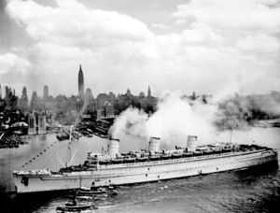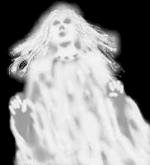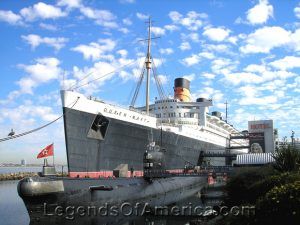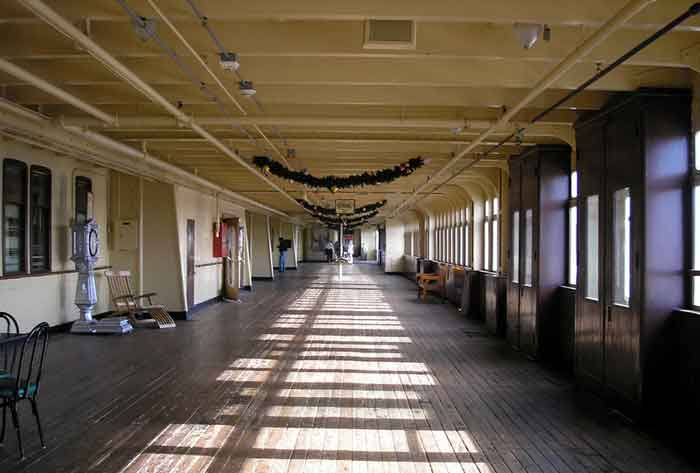By Paula Bates
The Queen Mary has been named one of the world’s “Top 10 Haunted Places” by Time Magazine, and its haunted history is punctuated by at least 49 on-board deaths, including a crewmember who was crushed by a hatch during a routine drill, a young girl who drowned in one of the pools, and a ship’s officer who mistakenly drank poison thinking it was gin.
So what makes the Queen Mary unique among other haunted places in the world? The amount of observed phenomena grew so great, that in the early 1990s, the company overseeing the Queen Mary at the time contracted professional Anomalist and Parapsychologist, Christopher Chacon, to undertake an extensive and thorough scientific investigation of the phenomena.
But to understand this fascinating ship and why it is such a hotbed for paranormal activity, it’s important to go back to the beginning of the story and follow the Queen Mary’s journey through time and across oceans.
The Queen Mary began her life as a luxury British ocean liner, launching in 1934, christened by her namesake, taking her maiden voyage in 1936. For three years, the Queen Mary ferried passengers across Atlantic faster and more comfortably than ever before.

During her service in the war, the Queen Mary was painted a drab grey, hence her nickname, the “Grey Ghost.”
When World War II broke out, she was stripped down, repainted, and nicknamed the “Grey Ghost” while being used as a transport ship for allied soldiers. This was a dramatic change for the Queen Mary, but her speed and stealth abilities proved invaluable during the war. Tragically, in 1942, the Queen Mary collided with the HMS Curacoa, another ship transporting allied soldiers, which resulted in the loss of 337 lives.
After the end of the war, the Queen Mary was refitted again for passengers in 1947 and went on to complete 1,001 total transatlantic voyages in her day, attracting high profile passengers such as Hollywood actors, famous musicians, and even British royalty on several occasions.
Her final transatlantic passage was completed in 1967, ending in Long Beach, California, where the ship still remains to this day, serving as a museum, tourist attraction, and hotel.
Haunting Accounts
Hundreds of people have reported experiencing paranormal phenomena (even skeptics having encountered inexplicable events) aboard the Queen Mary in the days since she was permanently moored in Long Beach. These accounts come from a broad spectrum: everyone from visitors on board for only a short time to people employed long-term on the ship for many years.
Depending on who you ask, some areas on the Queen Mary are said to be more haunted than others with a wide variety of different phenomena being experienced in every area. For example, many have heard a little girl’s voice in the pool room where little Jacqueline Torin, “Jackie,” drowned. She was only around five years old at the time of her death, and guests often hear her calling for her parents.
Another area of the ship with frequent reports is the boiler room. Here, people have seen an apparition thought to be that of John Henry, a worker who is said to have passed away while on the job and whose remains were discovered there.
A few examples of the hundreds of different types of phenomena people have experienced over the years include; encountering a variety of apparitions that vanish (smokey translucent forms, dark shadowy silhouettes, solid normal-looking), physical contact (touched, pulled, grabbed, etc.), inexplicable voices and conversations, cold and hot spots, power surges, and cabinets, doors and furniture moving seemingly on its own. The incredible variety, frequency, and potency of the phenomena make it clear that the Queen Mary is truly a haunting like no other.
Paranormal Investigations
Many self-proclaimed paranormal investigators and psychics have been drawn from around the world to conduct investigations into these phenomena, but only one investigation stands out among the rest and was the only officially sanctioned one ever conducted…
Enter the world’s top paranormal investigator: Christopher Chacon.
In the early 1990s, world-renowned Parapsychologist and Anomalist Christopher Chacon conducted a scientific investigation of the property at the request of the company operating the ship. The 18-month, round-the-clock, investigation utilized an extraordinary array of state-of-the-art technology (monitoring everything from background radiation to air pressure, from magnetic fields to chemical content in the environment) that spanned the entire ship and a team of scientists (including physicists, medical doctors, chemists, etc.) dedicated to gathering and analyzing data. Additionally, over 1,500 people were interviewed and hundreds of controlled experiments were conducted. Great care was taken to establish scientific controls and maintain and ensure the integrity of data that was collected, repeating each data collection and assessment process multiple times.
Chacon is regarded as one of the world’s foremost authorities of paranormal phenomena, having conducted thousands of investigations worldwide for nearly forty years dealing with just about every type of phenomena imaginable. Chacon’s investigative approach is all-encompassing and follows a strict scientific protocol, assessing every imaginable dynamic and taking into consideration variables often bypassed and ignored by other investigators and teams. He also has the resources to conduct investigations and research that are unprecedented, including truck loads of the latest technology and an army of qualified scientists. Chacon emphasizes how the majority of paranormal events encountered around the world are explainable and the importance of first ruling-out logical explanations. “It is important to keep in mind that the overall investigation (of the Queen Mary),” says Chacon, “as well as each individual event documented, was assessed for psychological, physiological, environmental and circumstantial explanations, to name a few, to rule-out rational and logical explanations.”
In total, over 12,000 events were documented, with approximately 60% of those being determined to have explainable factors, leaving a little over 30% to be considered anomalous (or what most regard as paranormal or “haunt phenomena”), according to Chacon.
“After the 18 month investigation concluded, I returned to the Queen Mary on four separate occasions,” he said, explaining that each visit lasted 72 hours. He spent his time onboard the Queen Mary “conducting cursory assessments and applying various investigative models” that would later be studied further once the rest of the data was gathered.
Based on all of the data collected, in terms of a parapsychological approach, his conclusion is that the data “suggests phenomena with fluctuating composite characteristics,” which would explain the various types of haunt phenomena being documented and experienced by so many people.
What is a Haunting?
 So what exactly is a haunting and how is it defined? “While many still follow a simplistic black and white construct, the fact is there are actually many theories and theoretical variations, types and sub-types of these phenomena,” Chacon says in response to this question. His answer is proof of his unique hybrid scientific approach to the topic. Chacon goes on to describe a few basic categories theorized in modern parapsychology to describe haunt and poltergeist phenomena.
So what exactly is a haunting and how is it defined? “While many still follow a simplistic black and white construct, the fact is there are actually many theories and theoretical variations, types and sub-types of these phenomena,” Chacon says in response to this question. His answer is proof of his unique hybrid scientific approach to the topic. Chacon goes on to describe a few basic categories theorized in modern parapsychology to describe haunt and poltergeist phenomena.
He explains that this includes aspects that relate to the phenomena being either “residual” or “sentient” and those relating to an individual’s experience as “objective” or “subjective.” Breaking down the phenomena in this way helps us better understand and study the phenomena.
According to Chacon, a typical residual haunt is theorized as a mere impression “left behind upon an environment or object, like an echo or footprint, often being cyclic and often repeating its actions similar to a video-tape playing on a loop; producing visuals, sounds, etc., though itself possessing no consciousness.” There are many theories as to how and why this occurs, and some people believe this type of haunt phenomena maybe the first to be fully embraced by mainstream science.
For the next category of haunt phenomena, things get a little bit more unpredictable. A sentient haunting theory “is thought to possess some degree of awareness, feeling, perception, [or] memory,” and it could possibly be “reactive or responsive, even communicable,” says Chacon.
Sentient hauntings often produce more fear in those who experience them due to their erratic nature and potential to be believed malicious or intent on causing harm.
The next categories refer to whether or not a haunt is objective or subjective. “If it is an objective haunt,” explains Chacon, “the phenomena can physically occur in the environment independent of anyone experiencing it and can possibly be documented or recorded with various types of equipment.” These kinds of phenomena are easier to study than their subjective counterparts, which “can only be cognitively experienced by one or more select individuals, leaving no physical traces or characteristics in the environment.”
Chacon went on to explain various theories surrounding poltergeists and how in years long passed some in the parapsychological community categorized hauntings and poltergeists separately, thinking poltergeist phenomena to only be connected to an agent (specific living individual) or possibly some non related environmental element. He went on to describe how countless cases of these phenomena around the world has proven this to be not the case.
While these basic theories provide a framework for understanding and further study, Chacon cautions against placing too much emphasis on them, as well as interpreting them as individual separate types that are independent of each other. “Nothing can be farther from the truth,” he says, “as there have been countless haunt and poltergeist cases that are in reality some combination of one or more of any of these, as in the case of the Queen Mary.”
The future of paranormal research: will we ever know the truth?
Where does that leave us in terms of what people experience on the Queen Mary and in other uniquely haunted places? According to Chacon, further study is required, and these locations have the potential to provide valuable information to the field.
“While parapsychological theories were used to describe characteristics of the phenomena [that occurred aboard the Queen Mary],” he explains, “I cannot emphasize enough the importance of not rushing to conclusions regarding a phenomena and running the risk of misinterpreting and misdiagnosing it.”
In his work around the world with some of the most notoriously haunted places, Chacon has discovered that many traditional theories and concepts surrounding these phenomena “have been perpetuated for generations by belief systems, cultures and society, multimedia and entertainment, and even scientific exploration, [and] do not accurately convey their true origins, nature, dynamics and mechanics.”
Chacon believes it’s important to take an objective approach in determining “whether the phenomena are natural anomalies, a product of human consciousness (as in displaced RSPK: recurrent spontaneous psychokinesis) or a combination of both, and whether they are reactive, as well as sentient or residual.”
Closing
Despite how unsettling it may be to witness haunt phenomena such as what takes place on the Queen Mary, people are often drawn to these kinds of experiences. There is something intriguing and alluring about the unknown.
As of 2018, the Queen Mary now features such activities as a haunted tour and a haunted stateroom that guests can stay in. During the Halloween season, the ship and the adjacent port is transformed into a world-class Halloween extravaganza, complete with dramatic, high-tech scare mazes, theatrical séances, and all manner of live performances.
The owners of the Queen Mary have chosen to be open about what guests may experience, and they embrace every aspect of the ship’s past, including her tragedies and her haunted reputation, while educating her guests about the ship’s fascinating story and her important role in history.
©Paula Bates for Legends of America, October 2018.
About the Author: Paula Bates is a freelance writer and editor. Her self-published guidebook was endorsed by Rick Steves and adapted for official use by Paris Visitors Bureau in 2016, and she currently works from her home office in Houston, Texas with a variety of clients in podcast production, ebook publishing, and developmental editing.
Also See:
Ghosts of the Queen Mary in Long Beach, California


